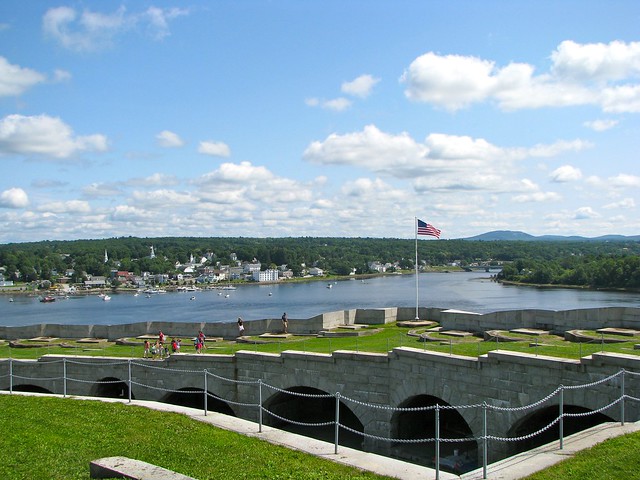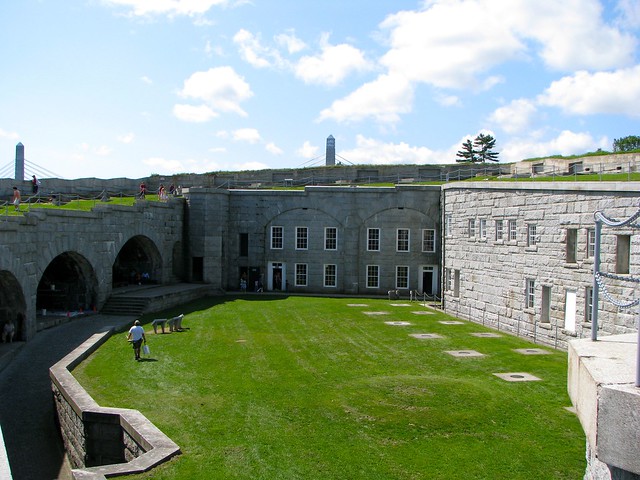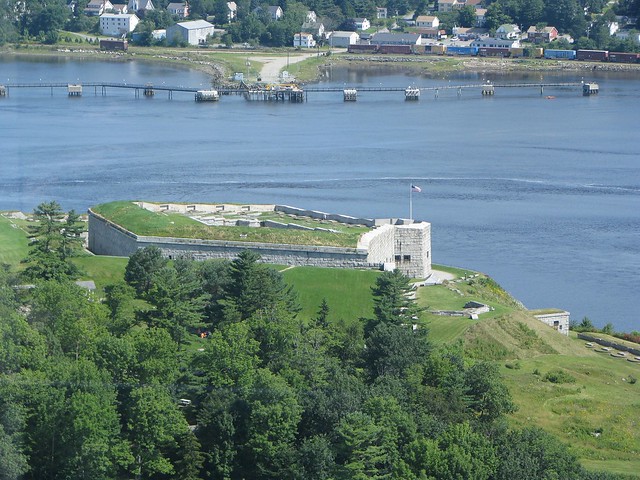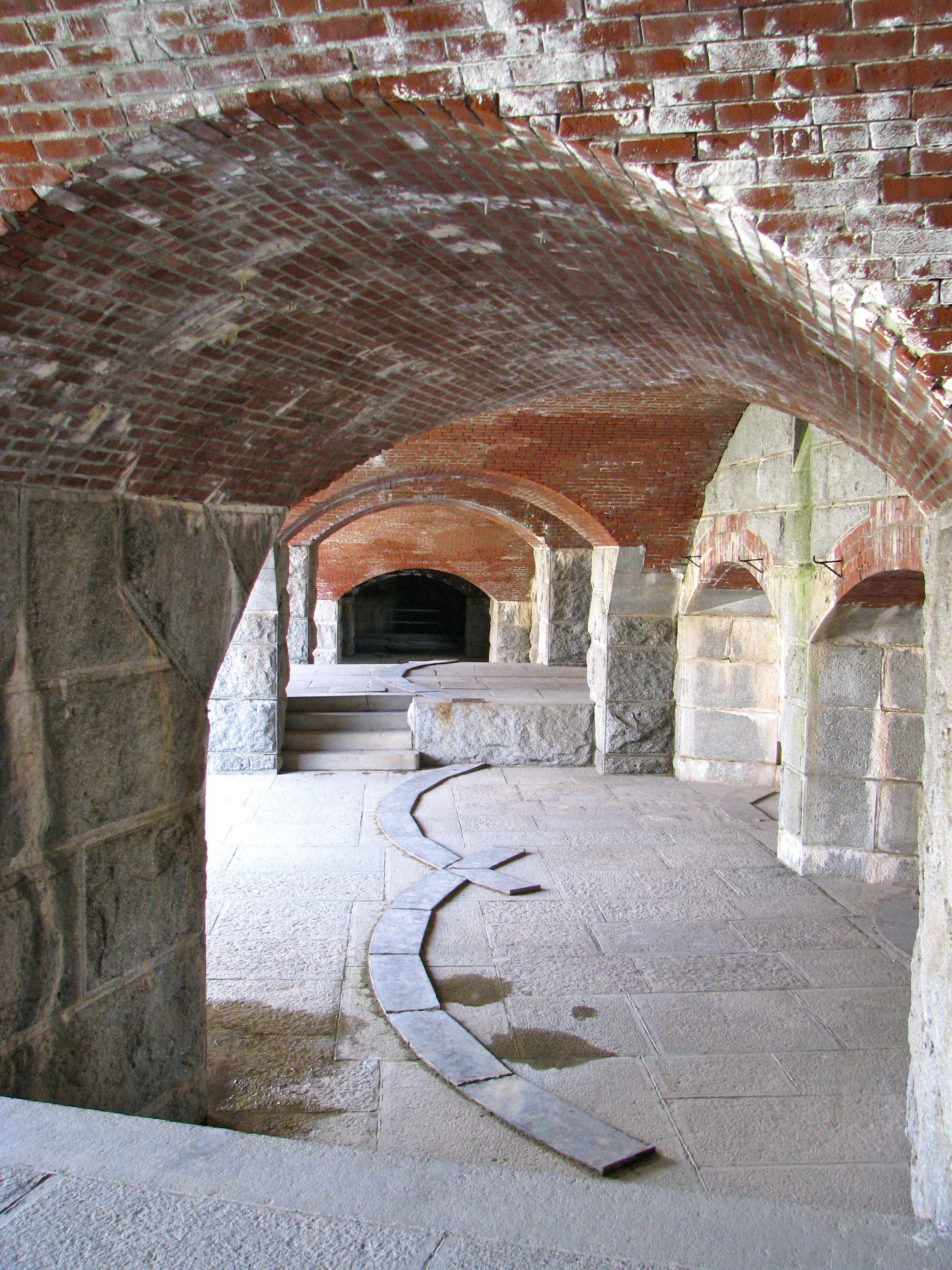Prospect, Maine (August 2009)
Before I describe Fort Knox, perhaps I should clear-up something. This place shouldn’t be confused with the “famous” Fort Knox you’ve probably heard of before. You won’t find any gold here although it shares a name with the fort in Kentucky that houses the United States Bullion Depository. No, this Fort Knox actually came earlier, built in Maine along the Penobscot River. It protected Bucksport and Bangor from a feared British invasion in the wake of territorial incursions that happened during the Revolutionary War and the War of 1812.
The confusion arises because both of the military facilities named Fort Knox honored the same individual, Henry Knox, the first U.S. Secretary of War who lived in nearby Thomaston, Maine. A fort in Maine named for Knox seemed natural, perhaps less so for a camp in Kentucky. Nonetheless the place with all the gold gained all the fame. What a shame. The fort in Maine retains its original, pristine condition.
Location

Any visitor traveling up Maine’s primary coastal highway, U.S. Route 1 (map) can get to Fort Knox pretty easily. This also works for visitors that prefer the Interstate rather than the scenic route, dropping from I-95 about twenty miles down to Bucksport.
The Fort Knox State Historic Site provides a two-for-one opportunity. For the price of a single admission, visitors gain access both to Fort Knox and the co-located Penobscot Narrows Observatory perched atop a 420 foot leg of the Penobscot Narrows Bridge. The fortress grounds remain open year-round but the fort itself opens only during the warmer months so you’ll want to plan accordingly. Someone could easily spend an entire morning or an afternoon between the two attractions. Alternately, they can be toured at a faster pace if simply stopping for a rest during a longer journey along the Maine coast.
A Strategic Position

Some might consider this an unusual location for a U.S. military fortification. However, it made perfect sense at the time of its construction. It seems unlikely to imagine today because of the special friendship between Great Britain and the United States, but the exact opposite held true in the early history of the fledgling former colony.
The United States viewed Great Britain as an enemy in the late eighteenth and early nineteenth centuries. Mistrust continued all the way up through the American Civil War in the 1860’s. Maine sat directly on the front line, an uneasy boundary between British Canada and the United States. Compounding that, Maine contained what must have seemed like unlimited natural resources. Its vast forests provided a nearly inexhaustible source of wood for construction or shipbuilding. Its seacoast and inland waterways harbored a great abundance of fish and crustaceans. It became an attractive target and it needed to be protected.
British Incursions
It wasn’t simply paranoia on the part of the United States. Britain invaded and captured large portions of Maine including the lower Penobscot River twice before in recent memory, during the Revolutionary War and again in the War of 1812. The British Navy destroyed a fleet of American ships near Bangor during the Revolution. They returned in the War of 1812. Although Bangor surrender unconditionally, the British looted the town and burned many ships in its harbor.
Residents of Maine’s coastline demanded protection. They did not wish to suffer a third humiliating defeat. Clearly the case for a coastal fortification had been made.
Continuing Mistrust

Bangor became the Lumber Capital of the World by this time and it was important economically to protect it. Britain remained an adversary. Border incursions by Canadian lumbermen led to growing tensions between the two nations. That resulted in an undeclared confrontation known as the Aroostook War in 1838-1839. The parties settled many of the underlying border issues diplomatically in the 1842 Webster–Ashburton Treaty. However, mistrust prevailed. The recent events finally spurred the United States to fund the construction of Fort Knox in 1844.
They chose a strategic location, not in Bangor itself but twenty miles downstream just below Bucksport. Here Verona Island split the Penobscot River and constricted its width. Here also stood a high bluff directly across from Bucksport on a bend in the river, with a commanding view and within easy cannon shot of any ship attempting to run past it. A fortress dug into the hillside would be practically impenetrable but could be outfit with sufficient firepower to protect Bucksport, Bangor and indeed the entire interior along this stretch of the Maine coastline. This single well-chosen spot could protect vital economic interests for a large swath of the lumbering industry.
Construction

Thus, construction began in 1844 and would continue slowly and intermittently all the way through 1869. Masonry coastal fortifications were in vogue during the first half of the nineteenth century and Fort Knox became part of that protective chain. They used locally-available materials, some of the finest granite available anywhere, found only five miles upriver at Mount Waldo.
The military constructed Fort Knox roughly in the shape of a pentagon. They further built a series of three batteries including some with their own magazines and with hot shot furnaces for artillery intended to catch wooden ships on fire in addition to smashing them. Protected underground passageways, dry moats, steep bluffs, and living quarters built into the hillside protected the occupiers. Fifteen-inch Rodman cannons enclosed in casements were placed strategically to create a deadly crossfire capable of hurling projectiles weighing as much as 450 pounds. This served as an intimidating deterrent to any foe hoping to capture the Lower Penobscot River.
Later Uses

Fort Knox never experienced hostile action. However, it was pressed into service during the Civil War like many of the other masonry coastal fortifications up-and-down the coast. Certainly the possibility of Confederate naval operation this far north would be remote but the fort could and did serve other purposes. A number of the Maine volunteers serving in the Union army trained in artillery and infantry tactics here beginning in 1863 and throughout the duration of the war. The Fort’s population held at about 150 soldiers. New trainees arrived at the fort as those completing training headed off to war. They did not occupy the living quarters however, as they were not yet habitable. Fort Knox was still under construction so they had to stay in temporary structures or tents on the premises.
The Spanish-American war of 1898 provided another brief splash of activity at Fort Knox. Fear that Spain might attack a U.S. city prompted a resurgence in activity at the masonry fortifications up-and-down the coast, including here. With the Spanish threat quickly dispatched, the fort went back into mothballs. The Federal government finally declared Fort Knox obsolete in 1923 and passed control to the State of Maine.
The site is remarkably well preserved owing to its solid construction and its lack of retrofitting as happened at many other coastal fortifications. It is also the lucky beneficiary of the efforts of a nonprofit group, the Friends of Fort Knox, who expend great efforts to preserve and maintain the fort.
Readers who have an interest in forts might also want to check my Forts, Fortresses and Fortifications page.

Leave a Reply